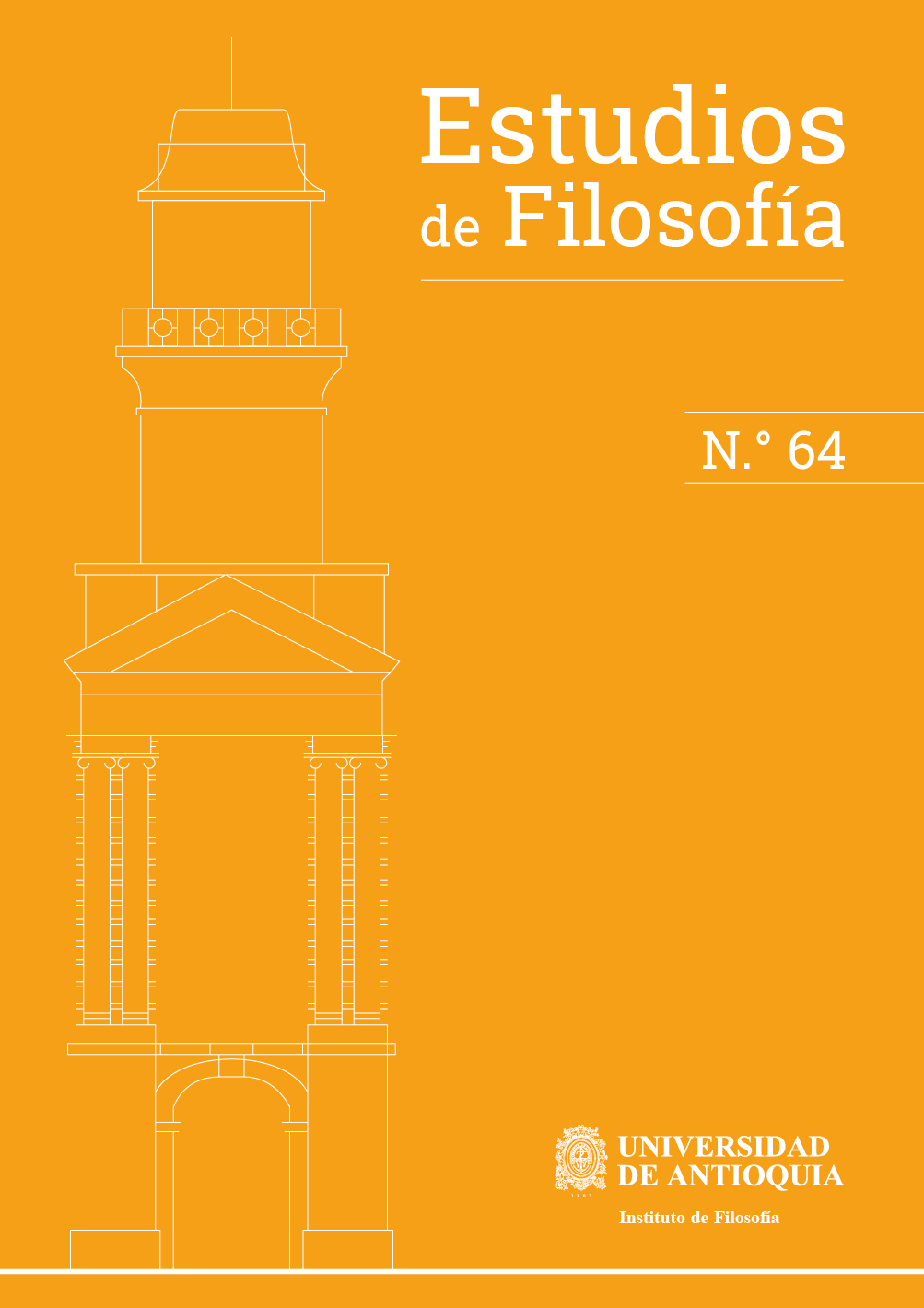No maps for these territories: exploring philosophy of memory through photography
DOI:
https://doi.org/10.17533/udea.ef.n64a03Keywords:
photography, art, memory, cultural memory, perceptionAbstract
I begin by examining perception of photographs from two directions: what we think photographs are, and the aspects of mind involved when viewing photographs. Traditional photographs are shown to be mnemonic tools, and memory identified as a key part of the process by which photographs are fully perceived. Second, I describe the metamorphogram; a non-traditional photograph which fits specific, author-defined criteria for being memory. The metamorphogram is shown to be analogous to a composite of all an individual’s episodic memories. Finally, using the metamorphogram in artistic works suggests a bi-directional relationship between individual autobiographical memory and shared cultural memory. A model of this relationship fails to align with existing definitions of cultural memory, and may represent a new form: sociobiographical memory. I propose that the experiences documented here make the case for promoting a mutually beneficial relationship between philosophy and other creative disciplines, including photography.
Downloads
References
Adams, S. (2019). A note on Ricœur’s early notion of cultural memory. Études Ricoeuriennes / Ricoeur Studies, 10(1), 112-124. https://doi.org/10.5195/errs.2019.465
Alea, N. & Wang, Q. (2015). Going global: the functions of autobiographical memory in cultural context. Memory, 23(1),1-10. PMID: 25585205. https://doi.org/10.1080/09658211.2014.972416
Assmann, A. (2006). Memory, individual and collective. In R. E. Goodin & Ch. Tilly (Eds.), The Oxford Handbook of Contextual Political Analysis (pp. 210-224). Oxford University Press. https://doi.org/10.1093/oxfordhb/9780199270439.003.0011
Barthes, R. (1980) Camera Lucida. Vintage Books.
Baudrillard, J. (1998) Paroxysm. Verso, London.
Berger, J. (1980). About looking. Pantheon Books. https://doi.org/10.3817/1280046209
Fawns, T. (2020). Blended memory: a framework for understanding distributed autobiographical remembering with photography. Memory Studies, 13(6), 901-916. https://doi.org/10.1177/1750698019829891
Garry, M. & Gerrie, M. P. (2005). When photographs create false memories. Current Directions in Psychological Science, 14(6), 321–325. https://doi.org/10.1111/j.0963-7214.2005.00390.x
Gibson, W. (2012). Distrust that particular flavour. G. P. Puttnam’s Sons.
Heersmink, R. (2020). Extended mind and artifactual autobiographical memory. Mind and
Language, 36,1-15. https://doi.org/10.1111/mila.12353
Heersmink, R. & McCarroll, C. J. (2019). The best memories: identity, narrative, and objects. In T. Shanahan & P. Smart (Eds.), Blade Runner 2049: a philosophical exploration (pp. 87-107). Routledge. https://doi.org/10.4324/9780429460036-6
Hoskins, J. (2005). Agency, biography and objects. In C. Tiller, W. Keane, S. Küchler, M. Rowlands & P. Spyer (Eds.), Handbook of Material Culture (pp. 74-84). SAGE. https://doi.org/10.4135/9781848607972.n6
Manier, D. & Hirst, W. (2008). A cognitive taxonomy of collective materials. In A. Erll & A. Nünning (Eds.), Cultural Memory Studies: An international and interdisciplinary handbook (pp. 253-362). De Gruyter.
Rowlands, M. (2016). Memory and the self: phenomenology, science and autobiography. Oxford University Press. https://doi.org/10.1093/acprof:oso/9780190241469.001.0001
St. Jacques, P. L. & Schacter, D. L. (2013). Modifying memory: selectively enhancing and updating personal memories for a museum tour by reactivating them. Psychological Science, 24(4), 537–543. https://doi.org/10.1177/0956797612457377
St Jacques, P. L., Montgomery, D. & Schacter, D. L. (2015). Modifying memory for a museum tour in older adults: reactivation-related updating that enhances and distorts memory is reduced in ageing. Memory, 23(6), 876–887. https://doi.org/10.1080/09658211.2014.933241
Sasaki, M & DiCicco, S. (2020). The complete story of Sadako Sasaki and the thousand paper cranes. Tuttle Publishing.
Sontag, S. (1979) On photography (electronic edition, 2005) Rosetta Books.
Sutton, J. (1998). Philosophy and memory traces: Descartes to connectionism. Cambridge University Press.
Wang, Q. (2021). The cultural foundation of human memory. Annual Review of Psychology, 72, 151–179. https://doi.org/10.1146/annurev-psych-070920-023638
Whittaker, S., Bergman, O. & Clough, P. (2010) Easy on that trigger dad: a study of long term family photo retrieval. Pers Ubiquit Comput, 14, 31–43. https://doi.org/10.1007/s00779-009-0218-7
Zhang, M. & Cross S. E. (2011). Emotions in memories of success and failure: a cultural perspective. Emotion, 11(4), 866-80. https://doi.org/10.1037/a0024025
Published
How to Cite
Issue
Section
Categories
License
Copyright (c) 2021 Alun Kirby

This work is licensed under a Creative Commons Attribution-NonCommercial-ShareAlike 4.0 International License.
Authors who publish with this journal agree to the following terms:
1. The Author retains copyright in the Work, where the term "Work" shall include all digital objects that may result in subsequent electronic publication or distribution.
2. Upon acceptance of the Work, the author shall grant to the Publisher the right of first publication of the Work.
3. The Author shall grant to the Publisher a nonexclusive perpetual right and license to publish, archive, and make accessible the Work in whole or in part in all forms of media now or hereafter known under a Creative Commons Attribution-NoCommercia-ShareAlike (CC BY-NC-SA 4.0), or its equivalent, which, for the avoidance of doubt, allows others to copy, distribute, and transmit the Work under the following conditions: (a) Attribution: Other users must attribute the Work in the manner specified by the author as indicated on the journal Web site;(b) Noncommercial: Other users (including Publisher) may not use this Work for commercial purposes;
4. The Author is able to enter into separate, additional contractual arrangements for the nonexclusive distribution of the journal's published version of the Work (e.g., post it to an institutional repository or publish it in a book), as long as there is provided in the document an acknowledgement of its initial publication in this journal;
5. Authors are permitted, and Estudios de Filosofía promotes, to post online the preprint manuscript of the Work in institutional repositories or on their Websites prior to and during the submission process, as it can lead to productive exchanges, as well as earlier and greater citation of published work (see The Effect of Open Access). Any such posting made before acceptance and publication of the Work is expected be updated upon publication to include a reference to the Estudios de Filosofía's assigned URL to the Article and its final published version in Estudios de Filosofía.















